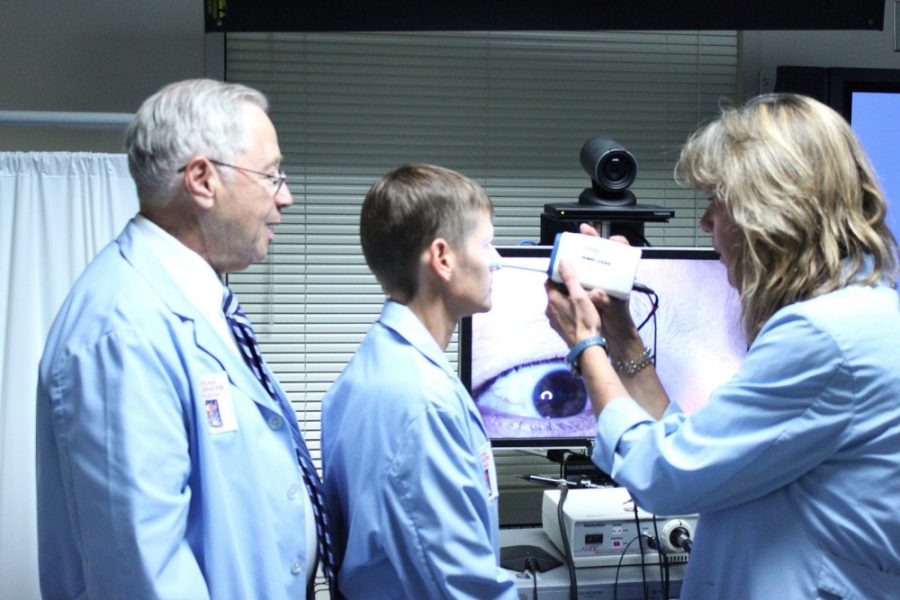People who are in need of medical treatment but live far from hospitals might soon become beneficiaries of an expanded UA program that aims to extend medical services to non-urban areas across the state.
The Arizona Telemedicine Program has received a $1.13 million grant to open a new center. The Southwest Regional Telehealth Resource Center will be part of a national network of seven other regional resource centers and one national resource center.
Telemedicine is a practice of medicine that uses a telecommunications system to provide clinical services at geographically separate sites. Services can be delivered in real-time using interactive video conferencing, or through store-and-forward which relies on the transmission of images and data for review immediately or at later time.
The funds were provided by the Office for the Advancement of Telehealth, part of the Health Resources and Services Administration, an agency of the U.S. Department of Health and Human Services, as part of a nationwide effort to increase the availability of telehealth resources and make medical records completely electronic.
Dr. Elizabeth Krupinski, vice chair of Radiology Research at University Medical Center, said that the goal of telehealth is to reach out to populations who otherwise could not easily receive specialist care. The new center, she said, will act as a training center and offer resources to those areas currently outside the reach of telehealth.
Dr. Ronald S. Weinstein has been the director of the Arizona Telemedicine Program since its inception in 1997. The program, he said, has grown to include branches in several fields of medical specialization.
Weinstein said that medical care at this time is delivered in a way that is very fragmented. This can result in poor patient care results, inconvenience for the patient and adds to the cost of healthcare. Implementation of electronic health records will address these issues.
“”We have two goals with this grant,”” Weinstein said. “”First, to help doctors implement the use of patient electronic health records in their offices, and second, to serve as a resource center for doctors who want to provide their patients with access to medical specialists using telemedicine. Both of these services will result in access to high quality healthcare.””
Implementation of electronic health records for patients to doctor’s offices is now a major agenda item for the Obama administration, Weinstein said. In the future, patients’ records will move seamlessly from practitioners outside the UMC into the UMC. Updated records will be available to the referring doctor after the patient leaves the UMC as well.
Weinstein said that teleradiology — one of the practice’s branches — includes services that are available at 25 rural and urban hospitals in Arizona and adjacent states. To date, UA radiologists have provided radiology diagnoses for over 800,000 patients outside of Tucson, he said.
Using another form of telemedicine, known as tele-echocardiology, infants in the neonatal intensive care unit at the Yuma Regional Medical Center have had their hearts examined by pediatricians at University Medical Center. In addition, telemedicine can be used to make decisions about whether to take these babies from Yuma to Tucson or Phoenix for future care.
UA-led telemedicine is not confined to the general Arizona public. The Arizona State Prison system uses telemedicine services, a media official at the Arizona Department of Corrections said. Thousands of prisoners have gained access to specialty medical care by telemedicine. The Arizona Telemedicine Program helped the prisons set up their telemedicine programs, which are now facilitated independently. This practice, Weinstein said, avoids the need to transport prisoners and thereby increases public safety.
Krupinski also said that same-day telemammography services are available to women at locations on Native American reservations. For example, Navajo women on the Navajo Reservation in northern Arizona can get their final report on breast imaging studies in less than two hours, actually before they leave the breast imaging centers. The radiologists who provide their diagnoses via teleradiology, can be 500 miles away from their patients.
“”This is an excellent example of an innovative healthcare service created by the Arizona Telemedicine Program and our UA Department of Radiology for rural patients and then offered to urban patients, here in Tucson,”” Weinstein said. “”To date, over 8,000 women have benefited from these rapid, same day, breast care diagnostic services, pioneered at the University of Arizona.””
Weinstein said that the relationship of a patient and doctor through telemedicine is very similar to the relationship experienced by patients in person with the doctor. With some types of telemedicine services, such as telepsychiatry, the patients “”see”” the doctor by face-to-face video conferencing.
Telepsychiatry is the form of telemedicine in highest demand, Krupinski said. Patients can work with psychiatrists at hospitals or with private psychiatrists who have positions for this purpose at the hospitals. She said the UMC even works with teenagers in Tuba City, Ariz.
Krupinski said patients are typically satisfied with this type of interaction. Also, she said, getting services from specialists can be burdensome otherwise. Oftentimes it involves commutes of hundreds of miles at greater cost to the patient.
UA students can also be involved with telemedicine through several courses at the undergraduate and graduate levels across several departments.
“”Arizona has a long tradition of leadership in telemedicine innovation,”” Weinstein said.









